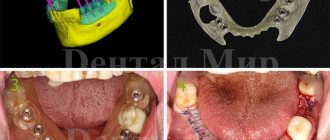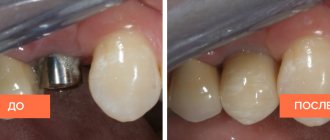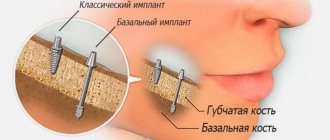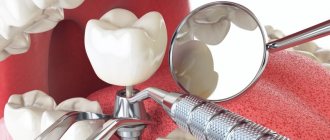Implantation without an incision is a marketing name that reflects the meaning of the procedure. This type of implant installation is also called transgingival, endoscopic, non-surgical or bloodless. This treatment has been known in Europe for 15 years , in Russia - relatively recently, but the popularity of the method is growing.
The process of installing an implant without an incision
What is implantation without a gum incision?
First, let's figure out what classical implantation is. This protocol involves the introduction of a titanium root (implant) into the bone tissue at the site of the missing tooth. The surgeon acts like this:
- Cuts the mucous membrane.
- Folds back the gingival flap.
- If necessary, it builds up bone tissue.
- Places an implant.
- Places stitches.
- After the implant has healed, a permanent crown is installed.
Tooth restoration takes 5-6 months , since it requires healing of the gums, fusion of the implant with the bone tissue, and installation of a crown after osseointegration.
Unlike the classical method, implantation without incisions allows you to skip several stages and avoid large incisions in the gums:
- To install the implant, one hole with a diameter of several millimeters is made.
- The implant is implanted.
- A gum former or temporary lightweight crown is immediately installed.
- After the implant has healed, a permanent crown is fixed in 2-3 months .
This treatment is recommended:
- people with diseases of the endocrine and cardiovascular systems;
- for those who are against surgery.
The bloodless method accelerates the restoration of the dentition.
Pros of dental implantation
As we have already said, implantation has not only disadvantages, but also very significant advantages. In many cases, they outweigh the disadvantages of dental implants; in addition, there are situations when implantation is the only way out - for example, when a denture causes a gag reflex, or in the case of the loss of all teeth, when there is no other support for the orthopedic structure.
Aesthetics
This is the first most important advantage: artificial teeth on implants cannot be distinguished from natural ones by their appearance, while dentures are often noticeable to a careful eye.
Naturalness of sensations
After implantation, artificial teeth are no different from your own - you don’t even need to get used to them, because... they completely reproduce the shape and function of natural teeth. It will take much longer to get used to dentures, and some people cannot get used to them completely.
Natural gum contour
The gum former restores its original shape and subsequently the gum contour completely coincides with the natural one, in contrast to prostheses, which constantly act on the gum, changing its shape.
Stopping bone atrophy
When a tooth is lost, the chewing load that it exerted on the jaw bone disappears, and this entails atrophy (resorption) of the bone tissue, which sooner or later will affect the neighboring teeth, leading to their displacement and loosening. The implant transfers normal load to the bone, just like a regular tooth, so atrophy does not occur and the neighboring teeth are not in danger.
Hassle-free power supply
Dietary restrictions are set only for the period immediately after implantation - until the artificial root takes root completely. After this, the implants are no different in their functions from natural ones, so they can chew any food, even hard ones. The implants will not suffer from this and will not fall out like dentures.
Preservation of adjacent teeth
A typical case of prosthetics is the grinding of adjacent teeth on which the prosthesis rests. This leads to their gradual wear and subsequent loss. The implant does not require treatment of adjacent teeth and allows you to save them completely.
Durability
All leading manufacturers provide a lifetime warranty on their implants. This means they will last for many years. Only the crown will need to be replaced approximately once every 10 years as it wears out. The implant itself will last for the rest of your life. And if something happens to it, the manufacturer provides a free replacement.
Full functionality
It is not always possible to fit dentures well so that they do not spoil diction or interfere with chewing food. There is no such problem with implants. They fully reproduce aesthetics, diction, and chewing function without any restrictions. And in case of complete loss of teeth, a denture on implants is the only alternative to constantly falling out false jaws.
Prevention
By preventing bone tissue atrophy and preventing the displacement and loosening of neighboring teeth, implants prevent the development of damage to their roots - periodontal disease.
We looked at the pros and cons of dental implants in general and, as we see, in some cases there is simply no alternative to installing implants. At the same time, the most important thing for the patient is not to choose certain models or manufacturers, but to choose a good doctor. Because implants from all leading manufacturers provide the same highest level of quality, but doctors have different abilities and experience.
At the Dental Master clinic you will find an experienced team of doctors with extensive knowledge and qualifications to carry out any type of implantation. An implantologist will select the most suitable material for your case, plan all stages of treatment, carry out the necessary diagnostics and install implants, with which you will not have any problems.
Features of the method
The method is not suitable for patients with bone deficiency for reliable fixation of an artificial rod. It is impossible to increase bone mass without making an incision in the gums, so non-surgical treatment is available to only 5% of people.
The volume of the mucous membrane is also taken into account. If the gum thickness is less than 2 mm, an implant cannot be installed using a non-surgical method. Under the influence of the titanium root, the mucous membrane will stretch and become even thinner. The thinner the gums, the greater the risk of inflammatory processes and implant rejection. The fact is that opportunistic bacteria, which are normally found in the oral cavity, can seep through the thin soft tissue and destroy the bone underneath. For thinned gums, we recommend enlarging the incision and performing implantation using a patchwork method.
In our Center, implantation without incisions is not covered by a lifetime guarantee.
Related articles:
- Other implantation methods
- Our guarantees
- Implant lifespan
How is endoscopic or transgingival dental implantation performed?
As you know, there are several types of implantation and surgical techniques. The endoscopic technique is perhaps the most comfortable for the patient, but difficult for the doctor. At the first stage, images of the jaws are taken, then a special program notes where and at what angle the implants will be located, after which the image and records are sent to the laboratory. Based on the data obtained, specialists spend some time making a surgical template, which marks exactly where the implant or implants should be installed. At the second stage, the specialist can only firmly fix the template in the patient’s mouth and carry out implantation, having previously made a small hole in the gum and bone.
Stages of bloodless implantation
With the seamless method, the implant is inserted through a puncture of the gum. Before the puncture, local anesthesia is given or the patient is put into medicated sleep.
- Using a circular mucotome, a circular incision is made for the titanium root. Preparing the hole begins by marking it with a ball bur. Sequential expansion is carried out using cutters of different diameters - from smaller to larger.
- Installation of an artificial root into the bone mass by screwing.
- Fixation of the healing abutment or abutment.
- It is possible to install a temporary lightweight crown immediately. After osseointegration, it is replaced with a permanent one.
Indications and contraindications
Implantation of an artificial root is used to restore lost teeth. Indications for use of the procedure:
- Missing one or more teeth;
- The need for rapid recovery;
- Absence of extreme dental units;
- Edentia.
Non-surgical dental implantation has a number of contraindications. It is strictly forbidden to carry out the procedure for people suffering from diseases of the gums, oral cavity, internal organs and circulatory system. It is not allowed to carry out the process of installing implants on patients who have been diagnosed with malignant processes in the body. In addition, contraindications apply to pregnant and breastfeeding women.
Features of the operation in our Center
- We begin transgingival implantation by creating a 3D model of the jaw. Our Center uses the “Nobel Guide” system. She creates an accurate virtual model based on mathematical calculations and produces a surgical template. With it, the doctor will determine where and at what distance to place the implants without cutting the gums. A tomograph and an X-ray machine do not provide such accuracy. The very name “implantation without incision” was invented by marketers to promote the “Nobel Guide” protocol.
- When the surgical template is ready, the doctor places it firmly against the gum and makes one or more holes for the implants. The procedure is performed under local anesthesia or sedation and is painless for the patient.
- After inserting the rod, the doctor places a temporary crown if the tooth is in the smile zone.
- After 2-3 months, the patient comes to the clinic for the second time and leaves with a permanent crown, indistinguishable from a natural tooth. In classical technology, the last visit takes place six months after the start of treatment.
What is meant by the concept of “dental implantation without surgery”?
Dental implantation has been successfully used by implant surgeons around the world for more than half a century. However, scientists are constantly working to develop new techniques to speed up and improve implantation technology. Today, using a surgical template, the doctor can accurately determine the location of implants and perform the operation without incising the gums and folding the mucoperiosteal flap, as happens with the classical technique. Naturally, you will still have to make an incision, but its dimensions will correspond to the diameter of the implant, not exceeding a few millimeters. This technology is called “dental implantation without surgery,” endoscopic, or transgingival implantation.
Rehabilitation period
Rehabilitation with the sutureless method takes less time compared to classical implantation. The operation is minimally invasive, without stitches, and therefore the implants take root quickly.
The risk of complications is minimal, since surgical manipulations practically do not injure fibrous tissue. But this does not mean that in the postoperative period the patient should not follow a certain regimen:
- On the recommendation of a doctor, antibacterial therapy, anti-inflammatory and painkillers are prescribed.
- On the first day you should not eat solid food.
- On the second day, if there is no pain, swelling and temperature, the gentle regime and anti-inflammatory drugs are canceled.
Instant implantation: advantages
Positive points:
- Minimal trauma;
- Comfort and safety;
- Fast survival;
- Guaranteed and long-term results.
If previously patients had no choice, today they have one. From now on, you can restore lost teeth once and for all quickly and without pain. An easy postoperative period is another advantage. For a conventional implant, the gums have to be sutured.
Dental implantation
, which does not require incisions, is accompanied by rapid and independent healing of the implant.
Many people still perceive implant surgery as quite painful due to the complexity of the procedure. But this can be avoided if you make the right choice of method. Someone will object: “But a dentist works with living tissues and nerves! How can you avoid pain? It's just the opposite. The work is carried out directly on the bone. That's why when installing the implant you will feel only a slight vibration and no pain! And the duration of the procedure is so short that most patients do not have time to feel anything. Installation takes a couple of minutes at most.
There are also benefits for gums:
- Integrity is maintained, so blood circulation is not impaired;
- Hematomas, swelling, risk of infection - all this can be forgotten due to the absence of incisions.
- Preservation of the natural texture of the gums in the frontal area, resulting in an aesthetically pleasing result.
Benefits of non-surgical implant installation
- The time to restore the dentition is reduced: after a maximum of 3 months, the patient is fitted with a permanent crown.
- The operation is faster: installing the rod using the classical method takes up to 8 minutes, and using the bloodless method – up to 2 .
- Rehabilitation is made easier: patients do not experience bruises, swelling, pain, or fever, and can work the next day after the implants are installed. It is especially important when restoring several teeth.
- The risk of implant rejection and infection is reduced since it does not require separation of the gum from the bone.
- Takes 10-15 minutes . Unlike the classic 3-stage method, with a non-surgical method the doctor installs a gum former or temporary crown immediately, without waiting for healing. The rehabilitation period is reduced by 2-2.5 times .
What are the advantages of the endoscopic method of dental implantation without incisions?
Before the advent of the surgical guide, implantologists could not determine with one hundred percent accuracy the location of the implant, so they had to open part of the jawbone by separating part of the soft tissue from it. Removing a gum flap is a rather traumatic procedure and is associated with a long rehabilitation period. The more soft tissue the doctor touches, the worse the patient feels after surgery. Severe swelling appears at the incision site, accompanied by pain and sometimes fever. In addition, due to the dissection of the gums, the circulation of blood and nutrients in the area where the implant is located is disrupted, which increases the period of its healing.
Transgingival or endoscopic implantation avoids all of the above complications. After it is performed, most patients do not experience any discomfort and can return to work the very next day. Using a template also eliminates the risk of improper fixation of the implant and makes the procedure quite quick. That is, if installing an implant in the classical way lasts about eight minutes, then implantation without a gum incision takes a maximum of two minutes. Minimizing time costs is especially important when it comes to restoring a large number of teeth. After all, the longer the surgeon performs the operation, the more swelling the patient will experience. As a result, thanks to the transgingival method, a person suffering from complete edentia becomes the owner of new and strong teeth without complications in just a few hours.
Price
Speed of the procedure does not mean cheaper. The amount of consumables and the cost of doctors’ work does not decrease. On the contrary, the price of implantation without an incision is higher due to:
- manufacturing a surgical template;
- mandatory three-time computed tomography.
The cost of a case for treatment is from 60,000 rubles . The amount includes the necessary procedures, the patient will not have to pay extra. For comparison, in Moscow clinics the price of the procedure starts at 45,000 rubles, but usually this amount is not final.
Prices for implants without bone augmentation
| Service | Price |
| Consultation | for free |
| Making a treatment plan | for free |
| NOBEL implant + installation | 55,000 rub. RUR 38,500 |
| Straumann implant + installation | 60,000 rub. RUR 38,500 |
| Osstem implant + installation | 25,000 rub. RUB 19,500 |
| Implantation of the entire jaw in one day without bone grafting using the All-on-4 method | from 165,000 rub. |
| Implantation of the entire jaw without bone grafting using the All-on-6 method | from 230,000 rub. |
| Service | Price |
| Consultation | for free |
| Making a treatment plan | for free |
| NOBEL implant + installation | 55,000 rub. RUR 38,500 |
| Straumann implant + installation | 60,000 rub. RUR 38,500 |
| Osstem implant + installation | 25,000 rub. RUB 19,500 |
| Implantation of the entire jaw in one day without bone grafting using the All-on-4 method | from 165,000 rub. |
| Implantation of the entire jaw without bone grafting using the All-on-6 method | from 230,000 rub. |
Implantologists and orthopedists of the Novadent dental center are certified by the manufacturers of implantation systems Nobel, AnyRidge, AnyOne, Astra Tech, Ankylos, Alpha Bio, MiS, Noris. You can see the prices for installing implants of these brands in this section.
Options for implantation without incision
Implantation without surgery can be conditionally called 2 more types:
- Laser - a laser beam is used instead of a scalpel. The bloodless incision of the gum is accurate, while at the same time disinfecting the area and minimizing the wound healing time is ensured.
- Instantaneous immediately after tooth extraction - there is no need to make incisions in the gums, since the implant is implanted into a fresh socket. But it is not always possible to carry out the extraction carefully, and the disfigured socket is not suitable for installing an implant.
Advantages
- minimal circulatory disturbance - no incisions are made in the vertical/horizontal direction, the flap does not peel off;
- bleeding after and during manipulation is practically absent, which is important for patients with diabetes mellitus and a history of immunodeficiency;
- rapid wound healing. Soft living tissues are regenerated very quickly, without the formation of hypertrophic/atrophic scars;
- less time is spent on the procedure;
- minimal pain - the patient does not feel pain or discomfort;
- high success rates (95-100%).
Flaws
:
- blind technique. Due to insufficient visual visibility, inadequate positioning cannot be ruled out. The ridge of the bone may have an hourglass configuration, a concave shape - in such a situation, a through hole may appear in the wall;
- there is no possibility to perform soft/hard tissue reconstruction;
- high risk of perforation of the lingual/buccal plate, damage to the roots of nearby organs;
- Intervention cannot be performed in case of bone deficiency.
Installing dental implants is an expensive type of restoration, the price of which depends on several factors. But at the same time, we should not forget about ease of use and beautiful appearance, which will remain throughout the entire period of operation. In this way, you can eliminate the disadvantage of missing any tooth and in any quantity.
Contraindications
Non-surgical implantation is especially suitable for people who are terrified of surgical intervention. But its use is possible only after examining the patient, since this type of operation is performed with absolutely healthy tissue and excellent bone quality in the area where the titanium root is implanted. Non-surgical implantation is prohibited in the following cases:
- advanced periodontitis;
- acute inflammation in the implantation area;
- periodontal cyst;
- narrow crest of the alveolar process;
- lack of bone tissue volume;
- swelling of the mucous membrane.










